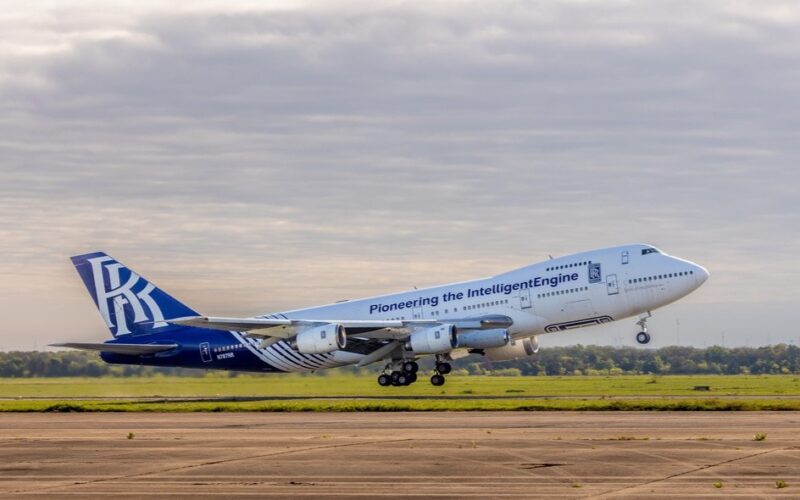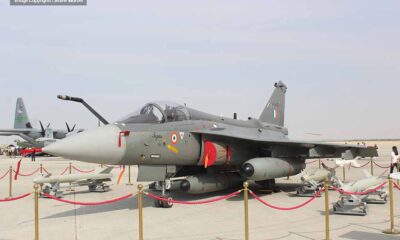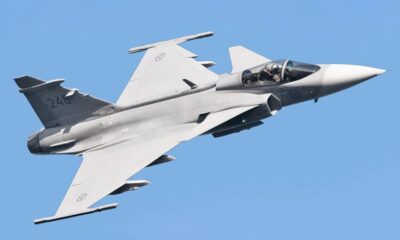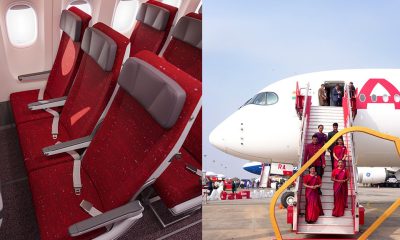Aerospace
Does Malaysia choose the Tejas fighter jet from India?

To improve its defence capabilities, Malaysia is looking for additional fighter aircraft. Since last year’s tender, the fighters are still being finalised. Many aerospace businesses from other countries applied for the contract; the top two were from Turkey and India, though the officials have not yet confirmed this.
Given its low acquisition cost and good technical ratings, India is the front-runner for Malaysia’s order of 18 Light Combat Aircraft (LCA). The offered package agreement also covers upkeep and spare parts for the country’s Sukhoi 30 fighter jets of Russian descent.
The pledge made by India to maintain Malaysia’s Sukhois in flight-ready condition is supported by the sizeable spares store and technical expertise of Hindustan Aeronautics Ltd (HAL).
South Korea and China are also vying for the contract, despite not having back-end agreements with Russian manufacturers to work on Sukhoi jets.
[the_ad id=”13562″]
-
Final decision will probably be made between governments.
Turkish Aerospace Industries (TAI) made the announcement that it is offering Malaysia joint production on a number of front-line military aircraft during the Defence Services Asia (DSA) 2022 expo in Kuala Lumpur. TAI’s Hürjet, which is under development, is submitted a bid for the Light Combat Aircraft/Fighter Lead-In-Trainer (LCA/FLIT) programme of the Royal Malaysian Air Force (RMAF).
The Malaysian Ministry of Defence (MoD) released a tender in June 2021 to fund the purchase of an initial 18 aircraft. Although it is still in development, the Hürjet will fly for the first time soon and the Turkish Air Force will get 16 of them starting in 2025. Hurjet might also go through testing that has been verified in flight, which might take longer. The Tejas aircraft, which were made in India, may deliver fighters in a 2 years, though, if the HAL secures a deal immediately.
The 19 Su 30 MKM fighters that Malaysia deploys are extremely similar to the Su MKI version that India uses.
According to the Economic Times, the dual package has been discussed, and a final decision will probably be made between governments.
Ordering spare parts and other supplies for outdated military equipment is becoming more and more challenging for a number of countries who possess Russian weapons.
-
Turkey’s Hurjet vs India’s Tejas
Hurjet is still in the development phase, whereas Tejas is already operational in the Indian air force. Tejas has a variety of offers for weapon packages, and since India has good diplomatic relations with other countries, some of its weapons have been jointly developed with foreign manufacturers. Hurjet is also offering some weapon packages, but they will be less in number than those offered by India’s HAL.
Tejas In order for Malaysia to improve its features with the HAL in the future, it is competing with other nations to release its Tejas Mark2 fighter, which is set to launch next year. China, Korea, and Russia all made offers to Malaysia. HAL Tejas is more inexpensive in their country when compared to other nations because of its price.
Spain orders 20 Eurofighter jets.(Opens in a new browser tab)
-
India offer Updates Radar and Avionics
A contemporary AESA radar, updated avionics, and the potential to incorporate a variety of air to air to ground weapons are all included in the LCA that India is offering to Malaysia.
Astra air-to-air missiles with a range beyond optical range have also been ordered by the Indian Navy and Air Force.
Teams from Malaysia visited India to examine the LCA offer, and to assure better servicing, the Indian side offered to build up an overhaul facility for the LCA fleet in Malaysia.
The India LCA costs $42 million; the cheap price has been made possible by economies of scale after the Indian Air Force ordered 83 of these jets as part of the Make in India programme.
[the_ad id=”13559″]
India’s offers to maintain Malaysia’s Sukhoi 30 fighter with HAL expertise and currently available Russian spare parts are open to India, but it maintains that doing so will result in more powerful defence fleet for Malaysia and a successful deal for both nations. Tejas fighter jet offers India’s strength which lies mostly in its arsenal of aircraft and weapons, which has elevated it to the top of Malaysia’s list of priorities. And even under the new contract, it can provide LCA and Dhrvua helicopter.
There are several indications that Malaysia may choose the Tejas for its defence squad, however Malaysia has not yet officially released it.

Aerospace
China Secures Production Certificate for Mass Production of Pilotless eVTOL Aircraft

The first passenger-carrying pilotless electric vertical takeoff and landing (eVTOL) aircraft in the world, the EH216-S, has received the Production Certificate for its eVTOL aircraft from the Civil Aviation Administration of China (CAAC).
This is a significant milestone for EHang Holdings Limited, the leading UAM technology platform company in the world. This outstanding accomplishment is another big step towards mass manufacturing for the eVTOL aircraft and the ensuing commercial operations, building on the ground-breaking acquisition of the Type Certificate and the Standard Airworthiness Certificate for the EH216-S.
The PC is a crucial certificate that the aircraft maker receives from the CAAC, the country’s aviation authority. By obtaining this certificate, EHang has demonstrated that it has set up a quality management system for mass production that satisfies the airworthiness regulation standards set forth by the CAAC, and the company has been given permission to continue producing mass quantities.
It is also a strong guarantee of the calibre of the goods made by EHang. Raw materials, supplier management, manufacturing organisation, production quality control, aircraft pre-delivery test, after-sales repair and maintenance, etc. are all included in the mass production quality management system for the EH216-S.
To ensure that every aircraft and its components that roll off the production line strictly adhere to the approved type design and safety requirements, the system sets clear guidelines and documentation for every step in the production procedure. This ensures comprehensive traceability and safety control.
Aerospace
Four Airbus A380 Superjumbos lined up to be scrapped

In a strategic move aimed at reclaiming valuable resources from the iconic Airbus A380 aircraft, VAS Aero Services and Dr. Peters Group have announced a significant collaboration.
This partnership marks a milestone in aviation logistics and aftermarket services, with four of these colossal planes slated for teardown and redistribution of used serviceable material (USM).
The venture between VAS Aero Services, renowned for its expertise in aircraft dismantlement, and Dr. Peters Group, a prominent Germany-based investment fund management firm, underscores a commitment to sustainable aviation practices. This isn’t their first foray into scrapping A380s; their successful partnership has already seen the dismantlement of these aircraft, making them pioneers in this niche.
Under the agreement, the latest consignment brings the tally to eight A380s entrusted to VAS by Dr. Peters Group. Managing Director Christian Mailly of Dr. Peters Group emphasized the trust placed in VAS, citing their unparalleled capabilities in dismantlement and aftermarket sales network. It’s a strategic move in response to the growing demand for quality USM parts, particularly with the resurgence in reliance on the A380.
Notably, the teardown process will be carried out at various locations, optimizing the positioning of harvested parts to cater to different markets. While some parts will be positioned in Europe to support operators in the region and the Middle East, others will remain in the Asia-Pacific region. This meticulous strategy ensures efficient access to spare parts, benefiting MROs and airlines across these markets.
The decision to retire these A380s comes at a time when operators are reassessing fleet strategies amidst evolving market dynamics. Despite initial plans for quick retirement due to the emergence of more fuel-efficient alternatives, factors such as a rebound in long-haul demand and delays in new widebody deliveries have prompted operators to reconsider. The A380, with its unique capacity and capabilities, presents a practical solution for short-term capacity management.
Aerospace
Rolls-Royce Launches Test Flights for Revolutionary Pearl 10X Engine

Rolls-Royce reports that the company’s dedicated Boeing 747 flying testbed has seen the successful start of the Pearl 10X, their newest aero engine designed for the business aviation industry.
Dassault, a French aircraft manufacturer, has decided to use this engine only to power their newest flagship, the Falcon 10X. As stated at last year’s Capital Markets Day, the commencement of flight testing represents a significant milestone for both Rolls-Royce and the Pearl 10X programme as the company concentrates on expanding in the business aviation industry.
The first Rolls-Royce engine to power a Dassault business jet is the Pearl 10X, the newest engine in the state-of-the-art Pearl engine family. The Pearl 10X was chosen by the French aircraft manufacturer as their new flagship model, demonstrating even more of Rolls-Royce’s dominance in the business aviation engine market.
Over the next few months, pilots and flight test engineers from Tucson, Arizona, USA, will put the engine through its paces. The flight test programme will comprise testing of the nacelle’s anti-icing system, in-flight relights, engine performance and handling checks at various speeds and altitudes, and fan vibration tests at various altitudes.
The new auxiliary gearbox, which enables higher additional power extraction, and the ultra-low emissions ALM combustor, which is compatible with 100% Sustainable Aviation Fuel (SAF), have undergone extensive testing as part of the ground-based development programme thus far. The engine will be the most potent business aviation engine in the Rolls-Royce lineup. It exceeded its intended thrust levels during the very first test run. With over 2,300 testing hours successfully completed on the Pearl 10X engine configuration as well as the Advance 2 demonstration, the programme is moving forward at a rapid pace.
With the most economical engine core available for business aircraft, the Advance2 engine, coupled with a high-performance low-pressure system, gives the Pearl 10X an exceptional thrust of over 18,000 lbf. With a 5% increase in economy over the previous generation of Rolls-Royce commercial aviation engines, the Pearl 10X



























